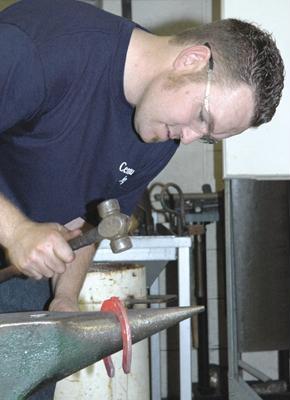After reading the keg shoe article describing a few of my shoe modification ideas in a recent American Farriers Journal, I decided some of the ideas techniques deserved further elaboration.
-
When I hammer down the inside edge of a keg shoe that swells when heated in the forge, the molecules in the steel expand when heated yet return to their original size when cooled. The reason the inner edge of a shoe thickens is because its radius is often tightened in the shaping process, which causes the steel to upset internally. The inner rim of the shoe becomes upset during the shoe shaping due to its contact with the horn.
Koons modifies a keg shoe during a clinic appearance in Wisconsin.
- When taken out of the box, many shoes serve basically as a sole pressure device. This is why it's important to fully understand the products you carry in your rig and know how to make them safe for the horses that you shoe.
- Moving additional steel into the toe provides a stronger and wider toe with a keg shoe. This is accomplished by moving steel from the inner rim of the toe to the outer edge by seating out the sole surface of the toe with half-face overlapping hammer blows.
- While I apply rocker toes and toe clips because I like their appearance, this is the most difficult combination of practical modifications to properly fit to the hoof. This requires seating the rocker toe down into the palmar surface of the hoof wall while also seating the clip back into the dorsal aspect of the hoof wall. You are trying to do all this all at once while not missing any of the perimeter of the hoof. If done correctly, a rocker toe will compensate for the amount of toe that grew out during the shoeing interval.
- Rockering the toe and toe clipping the shoe helps keep the hoof in great shape. It virtually eliminates the shearing forces on the nails within the hoof capsule.
- Horses often flinch from the pain and concussion of having clips hammered against their hoof wall, I've seen this clipping method cause deformities to the white line, the shape of the hoof and bruising to both the sole and laminae.
-
In the AFJ article I was quoted as saying, "You don't want punctures in the hoof wall from a clip. Shoe the horse so the foot will just bounce off if the animal happens to step on the clip."
My concern was not over a puncture to the hoof wall, as the hoof wall is insensitive. However, a sole puncture can cause severe damage to the sensitive sole, third phalanx and other sensitive or vascular structures in the hoof capsule. - You want to draw to draw or modify a clip so it is thin enough at the tip as to bend over or fold over in case the horse steps on it. Not only should a clip be thin at the tip, but it should also be somewhat rounded and not sharp.
- All but two of the horses I shoe are shod with clips and I've maintained this with most horses for 8 or 9 years. It has taught me that the base of the clip and the fit of the clip rather than clip height allow the clip to do its job properly.
- Clips should not be used as clamps, as they are meant to fit flush into a perfectly shaped socket in the hoof wall to eliminate unnecessary pressure on the hoof wall.








Post a comment
Report Abusive Comment